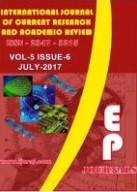Abstract Volume:5 Issue-7 Year-2017 Original Research Articles
 |
Online ISSN : 2347 - 3215 Issues : 12 per year Publisher : Excellent Publishers Email : editorijcret@gmail.com |
2Department of Civil Engineering, Quantum Global Campus, Roorkee, India
Cracks in concrete are inevitable and are one of the inherent weaknesses of concrete. Water and other salts seep through these cracks, corrosion initiates, and thus reduce the life of concrete. So there was a need to develop an inherent biomaterial, a self-repairing material which can remediate the cracks and fissures in concrete. Bacterial concrete is a material, which can successfully remediate cracks in concrete. This technique is highly desirable because the mineral precipitation induced as a result of microbial activities is pollution free and natural. As the cell wall of bacteria is anionic, metal accumulation (calcite) on the surface of the wall is substantial, thus the entire cell becomes crystalline and they eventually plug the pores and cracks in concrete. This paper discusses the plugging of artificially cracked cement mortar using bacillus spore former bacteria filling material in artificially made cuts in cement mortar which was cured in normal tap water. The effect on the compressive strength and stiffness of the cement mortar cubes due to the mixing of bacteria is also discussed in this paper. It was found that use of bacteria improves the stiffness and compressive strength of concrete. Scanning electron microscope (SEM) is used to document the role of bacteria in microbiologically induced mineral precipitation. Rod like impressions was found on the face of calcite crystals indicating the presence of bacteria in those places. Energy- dispersive X-ray (EDX) spectra of the microbial precipitation on the surface of the crack indicated the abundance of calcium and the precipitation was inferred to be calcite (CaCO3).
How to cite this article:
Murugalatha, N., Karan Babbar, Mohini Gupta, Aamir Suhail and Ayushi. 2017. A Study on Application of Biomolecules in Healing Concrete Cracks.Int.J.Curr.Res.Aca.Rev. 5(7): 19-27doi: https://doi.org/10.20546/ijcrar.2017.507.004



Quick Navigation
- Print Article
- Full Text PDF
- How to Cite this Article
- on Google
- on Google Scholor
- Citation Alert By Google Scholar
